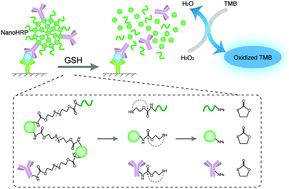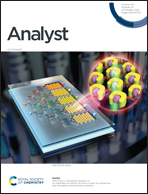Assembly of “carrier free” enzymatic nano-reporters for improved ELISA†
Abstract
Enzyme-linked immunosorbent assay (ELISA) is an economic and easy operation technique that has been widely used for the detection of protein in industry. However, the low loading capacity of the enzyme reporter has contributed to the low sensitivity of traditional ELISA, and the cross-linking procedures of the enzyme-labeled antibody in ELISA methods can lead to the inactivation of the enzyme, which will further decrease the sensitivity. To address this issue, herein we fabricated “carrier-free” nanoparticles to obtain a horseradish peroxidase (HRP) labelled reporter with a high HRP loading capacity. A disulphide-containing bis-N-hydroxy succinimide (NHS) crosslinker (NHS-SS-NHS) was used to control the link and release of traceless HRPs, thus without reduction of its enzymatic activity. The HRP nanoparticle (NanoHRP) was successfully applied for dot blotting and ELISA. When carcinoembryonic antigen (CEA) was used as a target, the detection limit of the NanoHRP-based ELISA was 0.005 ng mL−1, which was about 400 times more sensitive than traditional ELISA. A good correlation between the CEA concentrations and the response values measured by NanoHRP ELISA was obtained in the range of 0.005 to 1 ng mL−1. This concept could be exploited to improve ELISA tests, especially those requiring a high accuracy, to facilitate physicians in deciding the appropriate medical treatment.



 Please wait while we load your content...
Please wait while we load your content...